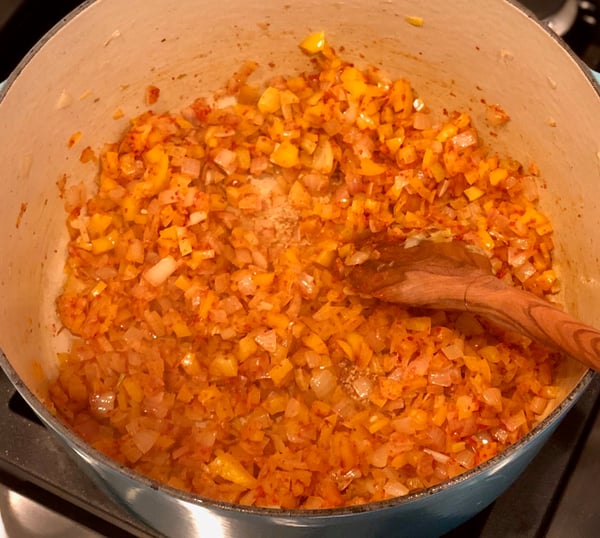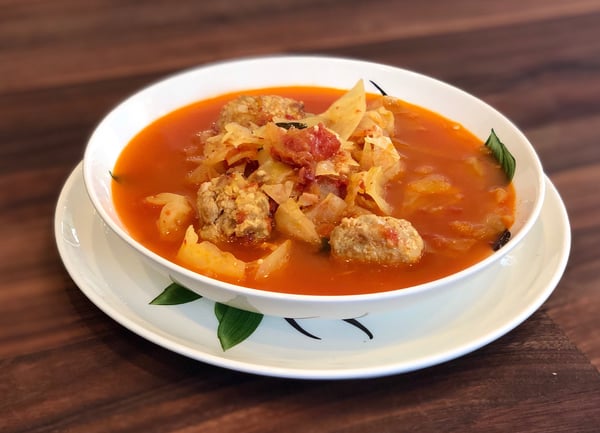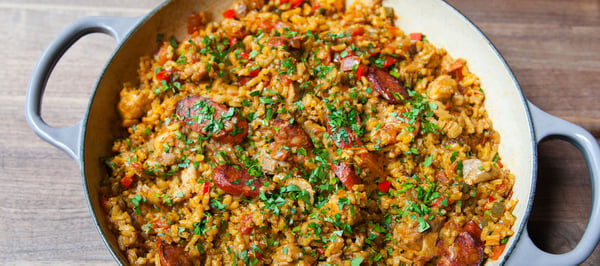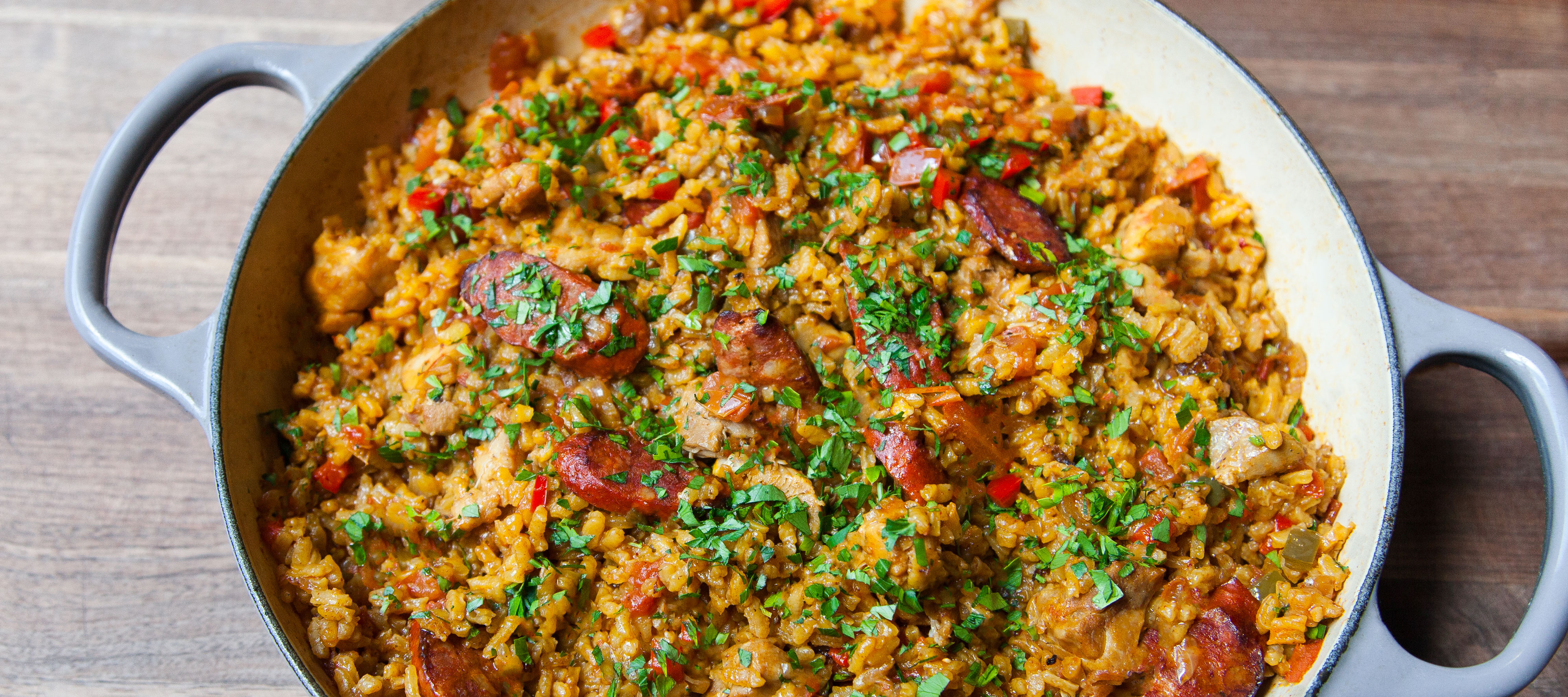Growing up homesteading in Iowa in the 60’s and 70’s gave me tremendous exposure to fresh food. We didn’t really eat frozen or packaged food, in part because we couldn’t afford it but also because it wasn’t as widely available. We cooked pretty much all of our meals, dining out only a few times a year.
The food we ate was simple but deliciously flavorful. My mom’s food was not bland but well-seasoned and interesting. However, my grandmother was not a good cook and didn’t really cook at all. Because of that, my mom never really new how to cook before she met my dad. His mother Ruby was an amazing cook and my dad found much comfort in his mother's cooking as he was about 6 foot 2” and 375 pounds. In those days, my mother understood when she married my father, she needed to learn to cook and quickly! My mom learned to cook from her mother-in-law, and she taught her all of her secrets, one of them being the use of aromatics.

My mom Irene, sister Debbie, brother Brian and very well-fed father Leroy
My mother learned to use aromatics to build interesting and in-depth flavor in her dishes. Mom didn’t have a ton of time to cook during the week but on Sundays, she delighted in preparing slow-cooked dishes that filled the house with delicious aromas. Sunday recipes weren’t incredibly difficult but rather longer cooking dishes like soups, stews and braised or roasted meats like Pot Roast. I loved waking to the smell of my mother’s cooking on Sundays.
She used aromatics to build the foundation of the dish. Her Potato Soup always started with bacon crisping in the pan before adding onion, celery and thyme. I’ll never forget that smell! My mom would start a pot roast by browning the meat and adding onions, celery and carrots to stew all day long in the oven together, the vegetables lending their flavor to the meat and the meat in turn to the vegetables. Iowa Chili always started with a sauté of onion, celery and green peppers until they were sweet and tender, then she would add chili powder and tomato paste, next came her meat to cook along with all of the aromatics, and finally she would add the tomatoes and beans.
If you cook at all, you are likely using aromatics when you cook - it's a foundational cooking technique. Let’s use the chili I mentioned above to illustrate what an aromatic is and what it does. I could take ground beef, onion, peppers, chili powder and tomato paste and just cook it all together before adding the tomatoes and beans and get a fine result. But if you take aromatics - the onion, celery and peppers - and saute them to bring out the sweetness and some fond (see my blog for more on fond), it will add more complex flavor to your dish. By sautéing spices which are fat soluble, the fat in the pan brings out their flavor and toasts the spices. Then when you sauté the tomato paste you concentrate the flavor and incorporate the aromatics' flavor right into the tomato paste. What’s in that pan is already tasty and appealing, those extra steps built a strong foundation to flavor your chili.
I think it is so cool that my mom who learned to cook in Fort Dodge, Iowa learned some of the same techniques taught in Italy, China, Portugal, Puerto Rico, Germany, Spain, Thailand and virtually every country in the world. Each country has their own combination of aromatics that are central to their way of cooking and to their unique regional flavor profile. What I find so interesting is that although most home cooks and chefs utilize aromatics regularly, there really isn’t a lot of information out there on the subject. As an example, the term “aromatic” really isn’t a mutually agreed upon culinary term. If I were talking to any chef and referred to Mire Poix as an aromatic, they would all understand what I meant and would not bat an eye at the term. If I were to make a blanket statement to that same group of chefs about aromatics they may need a little more information to understand what I was talking about. If I used the term Chinese aromatics, Thai aromatics, Italian aromatics, Cajun aromatics, French aromatics or Portuguese aromatics, more than likely they would understand I was referring to the flavor profiles prevalent to each of these countries. What they may not entirely understand is in what way I intended to use these flavors.
I think part of the issue lies in the term aroma itself, as aroma refers to the sense of smell. In cooking however, aroma is really the prominent sense we use to taste things. We discuss this in our popular Flavor Dynamics class in a fun experiment. We have everyone plug their nose and close their eyes. We put a jelly bean in their hand and ask them to put it in their mouth and chew. They keep their nose plugged and try and taste what flavor the jelly bean is, but they can’t, that is, until they unplug their nose. It is only then they can identify not the taste of the jelly bean but the flavor of it. Flavor is the combination of olfactory, visual senses and taste.
It would be great if one of you could add to the Miriam Webster’s Dictionary or Wikipedia or wherever such terms are solidified: “Aromatics “ is a culinary term meaning assortment of extremely flavorful ingredients usually including a combination onion, garlic, celery, carrots, peppers and herbs, sauteed in butter, oil or animal fat to intensify, deepen and add complexity to recipes; examples are Mire Poix, Soffritto, Sofrito, Holy Trinity, Refogado and Suppengrun.
Soffritto and Refogado

Sauteed onion, peppers and garlic
There are many regional versions of Refogado or Soffritto throughout Latin America and Latin Europe. The name will change and the ingredients will change regionally, so much so it would difficult to capture them all. These countries are masterful at using aromatics, these regions tend to sauté their aromatics very well and chop their ingredients finely.
Refogado: Classic Portuguese aromatic of garlic, onion, saffron and smoked paprika, often with the addition of bay leaves and tomato to flavor dishes such as rice, meats, seafood and stews.
Soffritto: Classic Italian aromatic of onions, carrots, celery sautéed in lard, butter or olive oil, often with the addition of white wine, tomato, fennel and herbs to season sauces, meats, soups and stews.
Watch Soffritto being made for classic tomato sauce in my videos.
Sofrito: Classic Puerto Rican aromatic of onions, garlic, peppers, annatto, tomato often with the addition of cilantro, bay leaves, salt pork, olives and capers to season rice, soups, stews, seafood and meats.
Sofrito: Classic Ecuadorian aromatics of onions, garlic, peppers, tomatoes, cumin and cilantro used to season rice, soups, stews, seafood and meats.
Sofrito: Classic Cuban aromatic of onions, garlic, peppers often with the addition of white wine, cumin used to season rice, beans, meats, soups and stews.
Europe and United States
The aromatics used in Europe and United States can vary from those Latin American and Latin European countries in a few ways. The aromatics are not as frequently sauteed and can often be chopped quite large, such as in stock making.
Suppengrun: Classic German aromatic of carrot, celery or celery root, leeks, parsley and thyme used to season soups, sauces and meats.
Mire Poix: Classic French aromatic of onion, celery and carrots, often with the addition of parsley and bay leaves used to flavor dishes such as stocks, sauces and soups.
Holy Trinity: Classic Cajun/Creole aromatic of onion, celery and green peppers, often with the addition of garlic, is used to flavor dishes such as gumbo, jambalaya and etouffee.
United States: Classic aromatics of the United States can very region to region but largely include onion, carrots, celery often with the addition of peppers, garlic, bacon, salt pork and herbs used to season soups, sauces, stews, rice and meats.
Asian Countries

Thai Meatball Soup
Asian cuisine is built on aromatics, and they are used two or three times in a recipe: in the base sauté, as an ingredient in the dish as well as in the accompanying sauce. Each of these countries employs many more aromatic ingredients than are listed below, but I wanted to highlight the most authentic and consistent ones.
These lists do not include the ingredients such as soy sauce, fish sauce and others that are added to achieve true authentic flavors in a dish. This blog is long enough!
Chinese Aromatics: Classic flavors are scallion, ginger and garlic often with the addition of black pepper, chili, chive, 5 spice powder, star anise and cilantro.
Thai Aromatics: Classic flavors are garlic, shallot, ginger or galangal, kaffir lime leaves, lemon grass often with the addition of chili, cilantro, mint, basil and scallion.
Indian Aromatics: Classic flavors are garlic, ginger, onion, ghee often with the addition of turmeric, cumin, coriander, curry leaves, garam masala, cardamom, chili and cilantro.
Korean Aromatics: Classic flavors include scallion, garlic, ginger often with the addition of black pepper, sesame and chili.
There are countless other cuisines and aromatics associated with each one of them. If you have a favorite aromatic you like, please share in the comments. And if you have any regional names for your aromatics, I know others would love to learn them as would I, so please share those below as well.
If you take chicken and sauté it in Chinese aromatics you have the start of some authentic Chinese flavor. Play around and have some fun learning how to both bump up the flavor in your cooking and experiment with some new flavors! We constantly use aromatics in our classes so if you want some hands-on experience and aroma of using aromatics check out our Bayou Bash, Taste of Thailand, Ramen Workshop or A Night in Spain classes.
You'll learn how to make a delicious Paella in the Spain class, but here's a version to get started on in the meantime.

Chicken and Chorizo Paella
Scroll down for a printable version of this recipe
Yield: 4-6 servings
Active time: 35 minutes
Start to finish: 1 hour, 10 minutes
2 tablespoons grapeseed oil
1 pound chicken thighs, boneless and skinless, trimmed and cut into bite-size pieces
Salt and pepper to taste
1/2 pound Spanish chorizo, cut into 1/2-inch coins
1/2 green pepper, julienne
1/2 red pepper, julienne
1/2 onion, medium dice
2 plum tomatoes, medium dice
1 pinch saffron
2 cloves garlic, minced
1 teaspoon sweet Spanish paprika
1 1/2 cups Arborio rice
4 1/2 cups chicken stock, warmed
Salt and pepper to taste
1/2 cup frozen peas, defrosted
1 tablespoon fresh parsley, rough chopped
- Heat a heavy, wide pan over medium-high heat, and add the grapeseed oil.
- Season the chicken with salt and pepper to taste, and sear in the hot pan until lightly caramelized on one side. Flip and repeat. Remove the chicken from the pan and set aside.
- Reduce the heat to medium.
- Add the chorizo to the pan, and cook until golden brown and crisp. Remove from the pan, and set on the same plate with the chicken.
- Gently sauté the green peppers, red peppers and onions until lightly caramelized, 4 to 5 minutes.
- Stir in the tomatoes, saffron, garlic and paprika. Cook, stirring frequently, until aromatic and the tomatoes are soft. Tip: The tomato juice will help release any bits of fond from the bottom of the pan.
- Stir in the rice and allow to cook for about 2 minutes.
- Pour the stock into the pan, and season with salt and pepper to taste. Return the seared chicken and chorizo to the pan, and stir.
- Bring the stock to a boil, and reduce the heat to a very low simmer. Cook, uncovered and undisturbed, until all of the stock has been absorbed and you no longer see bubbles of liquid in the pan. This will take approximately 30 to 35 minutes. Tip: Rotate the pan a few times during this process to ensure the paella is cooking as evenly as possible. Note: When all of the stock has been absorbed the bottom of your paella will develop that quintessential crispy layer that’s considered to be the best part of the dish!
- Sprinkle the top with the peas and parsley, and allow to rest for 5 minutes before serving.

ingredients:
- 2 tablespoons grapeseed oil
- 1 pound chicken thighs, boneless and skinless, trimmed and cut into bite-size pieces
- Salt and pepper to taste
- 1/2 pound Spanish chorizo, cut into 1/2-inch coins
- 1/2 green pepper, julienne
- 1/2 red pepper, julienne
- 1/2 onion, medium dice
- 2 plum tomatoes, medium dice
- 1 pinch saffron
- 2 cloves garlic, minced
- 1 teaspoon sweet Spanish paprika
- 1 1/2 cups Arborio rice
- 4 1/2 cups chicken stock, warmed
- Salt and pepper to taste
- 1/2 cup frozen peas, defrosted
- 1 tablespoon fresh parsley, rough chopped
instructions:
How to cook
- Heat a heavy, wide pan over medium-high heat, and add the grapeseed oil.
- Season the chicken with salt and pepper to taste, and sear in the hot pan until lightly caramelized on one side. Flip and repeat. Remove the chicken from the pan and set aside.
- Reduce the heat to medium.
- Add the chorizo to the pan, and cook until golden brown and crisp. Remove from the pan, and set on the same plate with the chicken.
- Gently sauté the green peppers, red peppers and onions until lightly caramelized, 4 to 5 minutes.
- Stir in the tomatoes, saffron, garlic and paprika. Cook, stirring frequently, until aromatic and the tomatoes are soft. Tip: The tomato juice will help release any bits of fond from the bottom of the pan.
- Stir in the rice and allow to cook for about 2 minutes.
- Pour the stock into the pan, and season with salt and pepper to taste. Return the seared chicken and chorizo to the pan, and stir.
- Bring the stock to a boil, and reduce the heat to a very low simmer. Cook, uncovered and undisturbed, until all of the stock has been absorbed and you no longer see bubbles of liquid in the pan. This will take approximately 30 to 35 minutes. Tip: Rotate the pan a few times during this process to ensure the paella is cooking as evenly as possible. Note: When all of the stock has been absorbed the bottom of your paella will develop that quintessential crispy layer that’s considered to be the best part of the dish!
- Sprinkle the top with the peas and parsley, and allow to rest for 5 minutes before serving.












